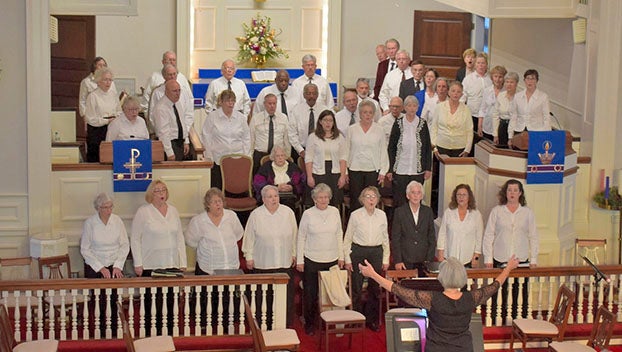Cell Tower Approval: The Do's And Don'ts
Published 4:27 pm Thursday, June 2, 2011
BUCKINGHAM – Supervisors and planning commissioners recently held a worksession that included a presentation by CityScape Consultants on probable reasons for denying and/or approving wireless communications facilities.
Additionally, Zoning Administrator/Planner Rebecca Cobb provided an overview of proposed changes to the zoning ordinance.
Following Cobb's presentation, supervisors and commissioners voted to schedule a joint public hearing on those proposed changes to coincide with the June 13 meeting of the board of supervisors. <br />
Cityscape's Susan Rabold began with a review of a section in the Telecommunications Act of 1996 regarding a local governing body's authority to approve or deny a request for locating, constructing, and operating a wireless communications facility.
“The Telecommunications Act of 1996 added section 704, which is specifically about the regulation of wireless telecommunications in the 800 and 1900 megahertz frequencies,” Rabold stated. “The Telecommunications Act says that you have to allow the deployment of all wireless providers.”
She continued, “So you cannot say, we have plenty of 800 MGZ providers with built facilities and then tell a 1900 MHZ provider that we've already got a tower.” Rabold stressed, “You have to allow all the service providers.” She added, “The act allows all of them equal access to build-out their network.”
The consultant advised, “So your ordinance has to allow that-which it does. But your voting decisions also have to reflect that.”
Rabold explained that the county must act expeditiously on the requests and must render a decision within 150 days. She added that local zoning standards for towers may not supersede or undermine federal guidelines.
Drawing from the Telecommunications Act, Rabold quoted, “Any decision by a state or local government or instrumentality thereof to deny a request to place, construct, or modify personal wireless service facilities shall be in writing and supported by substantial evidence contained in a written record.”
Noting the lack of substantial evidence opens the door for legal action, Rabold clarified, “It means that you cannot arbitrarily turn down a request based on neighborhood response or adjacent property owners. There has to be some form of substantial evidence.”
The consultant defined substantial evidence as relevant evidence as a reasonable mind might accept as adequate to support a conclusion. Citing a court ruling, Rabold explained that generalized concerns from opposing parties are not considered substantial evidence for an unfavorable decision against a personal wireless service provider.
Focusing on the written decision, Rabold said it should include findings of fact and conclusions of law tied to the record, which would facilitate court review if a decision is appealed.
“So it means if you turn down a request, you have to provide logical reasons based on compliance with your zoning standards, public health and safety, property values, and public necessity,” shared Rabold.
She offered, “It cannot be because potential future may not require towers anymore. That is almost like hearsay versus concrete evidence.”
Rabold continued, “So when you look at your zoning, you really have very good grounds for making decisions.” She reminded her listeners that the county's ordinance allows deployment by providers; facilitates collocation; minimizes impact of wireless communication facilities; hierarchy; encourages use of public lands and buildings, and use of county-owned land.
Reviewing some sample findings of fact, Rabold focused on one that she said is heard a lot regarding the substantial injury to the value of other property in a neighborhood where a tower is proposed. She explained, “You have to have evidence of that. You can't take someone's opinion as being fact when they say it is going to damage my property values.”
She offered, “This particular one has not been tested in court. And it is very, very hard to prove.” Rabold explained that in some situations an appraiser is brought in to demonstrate a decrease in property values somewhere because of a tower.
“At the same time, though, we have the industry when they hear that someone is coming in to bring an appraiser, they will bring their own appraiser who will find where property values have not been influenced by the tower,” she shared. “It is a real tough one to build an argument around,” said Rabold, adding, “It is a matter of opinion, really.”
She added that in some communities people are starting to put a value on having wireless Internet/wireless phone service in their geographic area.”
Describing the issue of property values as a sticky wicket, Rabold encouraged supervisors and commissioners to build their arguments of denial, if it comes up, on other thought processes and the county's ordinances.
According to Rabold, in November of 2009, the FCC made a declaratory ruling that set up “shot-clock” nationwide timelines. That ruling calls for 30 days to notify applicant of incomplete application; 90 days to render a decision for collocations; and 150 days to provide a decision for new towers. She added that the 30-day notification is part of the 150-day period.
At that point, BOS Chairman Bill Talbert questioned why over 160 names on a petition against a proposed tower would not have any bearing on a reason for denial.
Rabold said there had to be valid reasons such as a conflict with the county's ordinances or conflict with the harmony or physical characteristics of certain areas of the county such as pedestrian pathways and bike trails.
However, she added that if the industry can validate a facility is needed and that need is demonstrated in the county's telecommunications master plan, there really is no grounds to deny it because the industry must be allowed access into the community.
Noting the areas in the county without cell phone service, Talbert said cell phone companies should be required to make service available countywide much like electric utility providers are required to do.
Continuing, Rabold brought up two other areas of caution when reviewing a request. She said requirements for tower lighting and markings are exclusively regulated by the FAA/FCC.
“Typically, towers under 200 feet do not have to be lit,” stated Rabold. However, she added that there are instances where it would be required such as along a ridgeline or nearing a landing strip.
She said the lighting requirement is one of the reasons why the county ordinance capped its towers at 199 feet. Rabold added that the locality could request a dual lighting system, which includes a white strobe during the day and a red strobe at night.
Radio frequency emissions is the other area that the locality cannot regulate or use as a reason to turn down a request, said Rabold. She pointed-out that at a recent public hearing on a proposed tower, a speaker brought up the issue of possible health hazards from RF emissions.
Rabold said the FCC has indicated that radio frequency emissions are non-ionizing radiation. “So it doesn't change the molecular structure of your cells. X-rays do-this does not,” she stated. The consultant added that an independent study by the World Health Organization supports that RF exposure from base stations are so low that human and animal health are not affected.
Emphasizing that a denial cannot be based on either of those two issues, she advised, “And, if you do, you are opening yourself up for litigation.”
Nearing the end of her presentation, Rabold listed the items that can be regulated. Included in that list were protection of public health, safety and welfare in regard to setbacks. Other items included landscaping, height, infrastructure type (lattice or monopole), siting strategies in compliance with the master plan, setbacks, locations preferences, fencing requirements, and geographical particulars cross-referenced with the comprehensive plan.
She concluded by emphasizing that all denials must be based on the provisions in the zoning ordinance and comprehensive plan.
Rabold stressed that the county has a very good framework in place to ensure that applications concur with the ordinance, telecommunications master plan, and the comprehensive plan.
Beginning her overview of round three of proposed changes in the zoning ordinance, Cobb advised they would be looking at business, light industrial, heavy industrial, recreation, landfill and waste disposal districts, and telecommunications.
In the business district, Cobb said proposed changes include combining uses in the permitted and special uses lists. For example, she explained retail would include apparel, sporting goods, and gift shops; and, link hotels, motels and B&Bs. Food stores would encompass bakeries, butcher shops, and candy stores.
According to Cobb, some definitions were added such as listing apartments in the business district as a secondary for situations where there may be an apartment over a business. Additionally, she said the proposal specified that a dry cleaning business in the business district would be defined as a “drop-off/pick-up station.”
Revisions in special uses include combining uses such as amusement centers, bowling alleys, pool halls and skating rinks. Similarly, dog grooming facilities and kennels would be grouped as would laundromats and dry cleaners.
In an effort to be business friendly, Cobb said revisions in the setback requirements include front setbacks of 50-feet on primary roads and 25-feet on secondary roads. However, requests for lower setback requirements may be taken to the board of supervisors, she added.
Side and rear setbacks include 10-feet if adjoining other business properties; 25-feet if adjacent residential or agricultural district; and, 50-feet if next to an industrial district.
Moving on to the light industrial district, Cobb said revisions include defining language to permitted uses for Assembling in Nature; and manufacturing with low levels of noise, smell, light and dust, and no discharge other than sewer. With special uses, the proposed revisions delete “heavy uses” but accommodate existing industries.
Proposed changes in the heavy industrial district include deleting repetitive uses; and, placing more uses that are noxious in the special use category.
Cobb said only minor changes were made for recreational and landfill districts.
Likewise, proposed revisions to Article 9, Telecommunications, are minor and include some changes in text. Cobb explained that the most significant change requires that along with notification of adjacent property owners, all property owners within 2,600 feet of a proposed tower must be notified.
“We want the community to know about this tower and be aware of it,” she advised.
Offering a preview of “what's next,” Cobb said she and the planning commission would be working on revisions for the watershed district. Additionally, they are working on an article for the zoning ordinance that will cover sign usage in all districts.
At the conclusion of Cobb's report, both the planning commission and the board of supervisors voted to hold the joint public hearing on June 13 at 7:20 p.m.
Before adjournment, Commissioner Patrick Bowe recommended that in preparation of an anticipated influx of applications for cell towers, the staff prepare a list of items that according to the Telecommunications Act and the FCC cannot be used to deny such requests. He explained that the list would not only provide a quick review of the issues but would also help inform the public.





